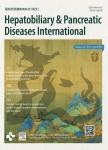Peginterferon alfa-2a for the treatment of chronic hepatitis C in the era of direct-acting antivirals
Peginterferon alfa-2a for the treatment of chronic hepatitis C in the era of direct-acting antivirals作者机构:Shanghai Roche Pharmaceuticals Ltd. Shanghai 201203 China Liver Disease Center Beijing Ditan Hospital Capital Medical University Beijing 100015 China
出 版 物:《Hepatobiliary & Pancreatic Diseases International》 (国际肝胆胰疾病杂志(英文版))
年 卷 期:2017年第16卷第5期
页 面:470-479页
核心收录:
学科分类:1004[医学-公共卫生与预防医学(可授医学、理学学位)] 1002[医学-临床医学] 100401[医学-流行病与卫生统计学] 10[医学]
主 题:chronic hepatitis C direct-acting antivirals hepatitis C virus peginterferon alfa-2a ribavirin
摘 要:BACKGROUND: The availability of novel direct-acting antivirals (DAAs) represents a new era of curative hepatitis C virus (HCV) treatment, with over 95% of patients infected with HCV genotype 1 achieving sustained virological response (SVR). Nevertheless, the majority of patients globally are unable to access these treatments because of cost and infrastructure constraints and, thus, remain untreated and uncured. DATA SOURCE: Relevant articles of peginterferon (PegIFN)-based treatments in HCV and sofosbuvir-based treatments, simeprevir, daclatasvir/asunaprevir, ritonavir-boosted paritaprevir/ombitasvir/dasabuvir, and grazoprevir/elbasvir, were searched in PubMed database, including general population and special population. RESULTS: PegIFN in combination with ribavirin remains an important and relevant option for some patients, achieving SVR rates of up to 79% in genotype 1 and 89% in genotype 2 or 3 infections, which increases for patients with favorable IL28B genotypes. Triple therapy of DAA plus PegIFN/ribavirin is effective in treating difficult-to-cure patients infected with HCV genotype 3 or with resistance-associated variants. Owing to its long history in HCV management, the efficacy, tolerability and long-term outcomes associated with PegIFN alfa-2a are well established and have been validated in large-scale studies and in clinical practice for many populations. Furthermore, emerging data show that IFN-induced SVR is associated with lower incidences of hepatocellular carcinoma compared with DAAs. On the contrary, novel DAAs have yet to be studied in special populations, and long-term outcomes, particularly tumor development and recurrence in patients with cirrhosis and/or hepatocellular carcinoma, and reactivation of HBV in dually infected patients, are still unclear. CONCLUSION: In this interferon-free era, PegIFN-based regimens remain a safe and effective option for selected HCV patients.



